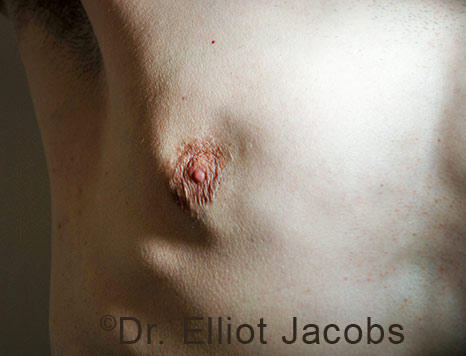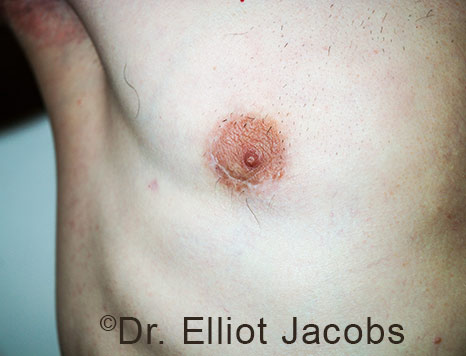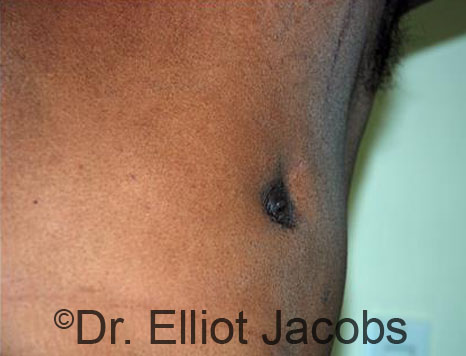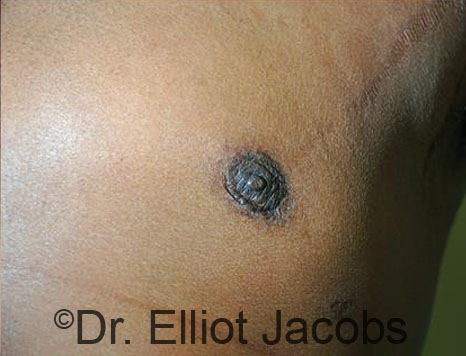Jump to this Section

What is a Crater Deformity?
A crater deformity is a condition that may occur after gynecomastia surgery, characterized by an indentation or hollow area on the chest. This irregularity typically appears at the site where the breast gland or excess fat was removed, notably just under the nipple. The severity of crater deformities can vary, ranging from subtle indentations to more noticeable hollow or irregular areas, significantly impacting the aesthetic outcome of the surgery.
Causes of Crater Deformity
The primary cause of crater deformities is due to over-zealous removal of tissue during gynecomastia surgery. In some cases, overly aggressive removal of tissue or uneven liposuction can result in an imbalance in the chest’s contour, leading to this indentation. The skill and experience of the surgeon play a pivotal role in preventing such outcomes. Dr. Jacobs is acutely aware of these risks and employs meticulous techniques to minimize the likelihood of crater deformities and he continues to help many patients throughout the U.S. with corrective surgery.
The best method of dealing with this problem is to avoid excess tissue removal in the first place. If that has occurred during surgery, then it must be recognized and treated before the operation is completed. If it is not recognized and is noticed immediately after the surgical dressings have been first removed, it will not improve by itself. It will require revision surgery.

Crater Deformity Repair Before and After Gallery
View our photo gallery full of patient before & after photos.
Crater Deformity Correction
For individuals facing the challenge of a crater deformity after gynecomastia surgery, there are effective correction options available. First, one must allow for healing to occur and all swelling to disappear. That will take at least 4-6 months.
Then a careful evaluation of the chest will reveal the depths of the crater and how much excess surrounding tissues are present. A “fat flap” technique has proven to be a permanent answer to most problems. This entails moving surrounding fat under the skin from multiple directions into the area of deficient tissue (crater) and then suturing them together. It is usually a “one and done” procedure. On rare occasions, fat grafting may be done for a shallow crater or it may be used to enhance the results of a fat flap procedure. The goal is to restore a smoother and more even chest contour.


Post-Surgical Care and Recovery
Post-operative care is also a critical factor in the overall outcome of surgery. Patients are advised to follow their surgeon’s instructions meticulously, including wearing compression garments and avoiding strenuous activities during recovery. These measures help reduce the risk of complications and ensure a smooth healing process.
Risks and Side Effects
Like any surgical procedure, crater deformity correction carries risks such as infection, scarring, and uneven chest appearance. Patients may also experience temporary numbness or changes in skin sensation.
Who is a Candidate for Crater Deformity Correction?
Suitable candidates typically include individuals who have undergone gynecomastia surgery and are left with noticeable indentations and contour irregularities of their chest. It is helpful to have some residual tissues surrounding the crater, which will provide the material for the fat flap procedure. Ideal candidates will also meet the below criteria:
- Good overall health with no underlying conditions that may impair healing.
- Non-smokers, as smoking can hinder the healing process.
- Realistic expectations about the outcomes and limitations of the correction procedure.


Benefits of Crater Deformity Correction with Dr. Jacobs
Undergoing the procedure with Dr. Elliot Jacobs, a board-certified aesthetic plastic surgeon in Boca Raton, offers significant benefits. Renowned for his expertise in gynecomastia surgery, patients can expect the following benefits:
- A tailored approach ensures each patient receives a personalized treatment plan.
- The use of advanced surgical techniques, including precise contouring.
- Minimized scarring and reduced downtime.
- A boost in self-esteem and self-confidence.
- Reduced psychological distress and improved well-being.
With Dr. Jacobs, patients can expect a significant aesthetic improvement to their chest that aligns with their vision of a balanced and aesthetically pleasing chest contour.

Choose Dr. Jacobs for Crater Deformity Correction in the USA
In his more than 35 years of experience, Dr. Jacobs has helped many patients throughout the U.S. correct the appearance of their chest. He developed unique surgical techniques to address complex chest conditions. He sees many revision cases at his Florida office. Patient safety and pleasing aesthetic outcomes are his top priority. Contact our office today to schedule your consultation.
Contact UsContact Us
Reach out to Dr. Jacobs today to schedule your consultation!
Frequently Asked Questions

How long after gynecomastia surgery can I consider crater deformity correction?
It’s advisable to wait until the initial surgical site is fully healed, typically 4-6 months, to allow for the natural settling of tissues.
Is the procedure covered by insurance?
As it is often considered a cosmetic procedure, insurance may not cover it. However, consulting with your insurance provider for specific policy details is best.
What is the recovery time for crater deformity correction?
Recovery time can vary, but most patients can resume normal activities within a few weeks, with full recovery taking a few months.
Will there be visible scarring from the correction procedure?
The most common surgical approach is to re-use the incision that was originally placed at the lower edge of the areola. If this has healed poorly from the initial surgery, then every attempt will be made to improve it. All wounds are sutured with dissolving sutures under the skin so that there are no sutures to be removed. While there may be some scarring, Dr. Jacobs uses techniques to minimize this and strategically places incisions to reduce visible scarring.





